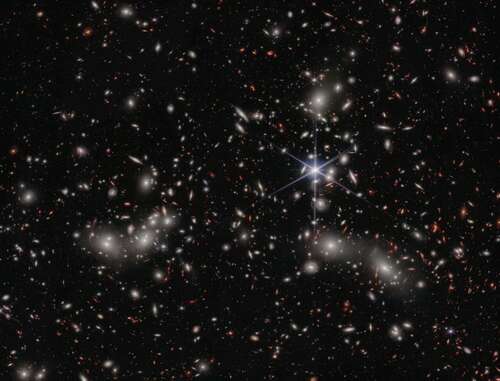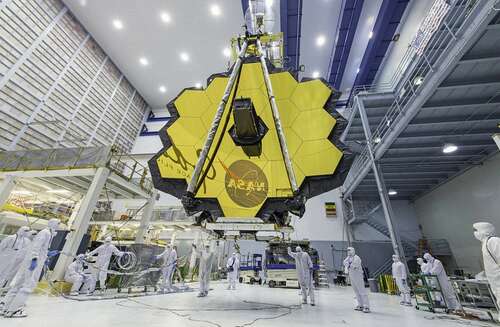The universe was once stuck in the Dark Ages.
It was time when, even after the first stars formed, thick gases suffocated their light. Space was dark.
Now, astronomers have used the powerful James Webb Space Telescope — an observatory orbiting 1 million miles from Earth — to reveal what may have ended the dark times and created the clear, observable universe we see today. They pointed the Webb telescope at a region of the cosmos called Pandora’s Cluster, a group of galaxies so massive that they warp space, like a bowling ball sitting on a mattress. This creates a curved cosmic lens, magnifying the objects beyond. “Light follows that bend instead of traveling in a straight line, distorting and brightening what’s behind the object,” NASA explains.
Using the combined power of this natural lens and the giant Webb telescope, scientists observed some of the faintest, and oldest, galaxies in space. Crucially, they saw these small galaxies (viewed as they were billions of years ago, as this light has taken that long to reach us) were generating huge amounts of ultraviolet light — enough to break down the dense clouds of gas that had saturated space. Ultimately, brilliant starlight was no longer hidden; the light was finally revealed, about 1 billion years after the universe began.
“These cosmic powerhouses collectively emit more than enough energy to get the job done,” Hakim Atek, an astronomer at the Institut d’Astrophysique de Paris who led the research, said in a European Space Agency statement. “Despite their tiny size, these low-mass galaxies are prolific producers of energetic radiation, and their abundance during this period is so substantial that their collective influence can transform the entire state of the universe.”
The research was recently published in the journal Nature. (The end of Dark Ages occurred at a time scientists formally call the era of “reionization.” That’s because this ultraviolet light, produced by giant stars inside galaxies, changed or “ionized” the thick fog of primordial atoms in the universe.)
“These cosmic powerhouses collectively emit more than enough energy to get the job done.”
The Webb image below reveals how astronomers were able to peer so deep into the early cosmos. Here’s what you’re seeing:
– Pandora’s Cluster: This group of massive galaxies are composed of the hazy white objects in the foreground. They create the natural magnification, called a “gravitational lens.”
– The red objects: These are the galaxies well beyond Pandora’s Cluster. “These lensed sources appear red in the image, and often as elongated arcs distorted by the gravitational lens,” the European Space Agency explains. “Many of these are galaxies from the early universe, with their contents magnified and stretched out for astronomers to study.”
Mashable Light Speed
– A vivid six-pointed object: This conspicuous object is a much closer star in the foreground. Its light has been diffracted by Webb’s six-sided mirrors.

Pandora’s Cluster producing a lens, called a “gravitational lens,” in front of distant galaxies.
Credit: NASA / ESA / CSA / I. Labbe (Swinburne University of Technology) / R. Bezanson (University of Pittsburgh) / A. Pagan (STScI)
Once the Webb telescope viewed such distant, faint galaxies through the cosmic lens, astronomers used an instrument called the Near-InfraRed Spectrograph, or NIRSpec, which separates the light coming from these far-off objects, similar to a prism. This allowed them to measure the ultraviolet radiation emanating from these early galaxies.
It was a whopping four times more radiation than previously thought; enough to end the Dark Ages.
The Webb telescope’s powerful abilities
The Webb telescope — a scientific collaboration between NASA, the ESA, and the Canadian Space Agency — is designed to peer into the deepest cosmos and reveal new insights about the early universe. But it’s also peering at intriguing planets in our galaxy, along with the planets and moons in our solar system.
Here’s how Webb is achieving unparalleled feats, and likely will for decades:
– Giant mirror: Webb’s mirror, which captures light, is over 21 feet across. That’s over two-and-a-half times larger than the Hubble Space Telescope’s mirror. Capturing more light allows Webb to see more distant, ancient objects. As described above, the telescope is peering at stars and galaxies that formed over 13 billion years ago, just a few hundred million years after the Big Bang.
“We’re going to see the very first stars and galaxies that ever formed,” Jean Creighton, an astronomer and the director of the Manfred Olson Planetarium at the University of Wisconsin–Milwaukee, told Mashable in 2021.
– Infrared view: Unlike Hubble, which largely views light that’s visible to us, Webb is primarily an infrared telescope, meaning it views light in the infrared spectrum. This allows us to see far more of the universe. Infrared has longer wavelengths than visible light, so the light waves more efficiently slip through cosmic clouds; the light doesn’t as often collide with and get scattered by these densely packed particles. Ultimately, Webb’s infrared eyesight can penetrate places Hubble can’t.
“It lifts the veil,” said Creighton.
– Peering into distant exoplanets: The Webb telescope carries specialized equipment called spectrographs that will revolutionize our understanding of these far-off worlds. The instruments can decipher what molecules (such as water, carbon dioxide, and methane) exist in the atmospheres of distant exoplanets — be they gas giants or smaller rocky worlds. Webb will look at exoplanets in the Milky Way galaxy. Who knows what we’ll find?
“We might learn things we never thought about,” Mercedes López-Morales, an exoplanet researcher and astrophysicist at the Center for Astrophysics-Harvard & Smithsonian, told Mashable in 2021.
Already, astronomers have successfully found intriguing chemical reactions on a planet 700 light-years away, and as described above, the observatory has started looking at one of the most anticipated places in the cosmos: the rocky, Earth-sized planets of the TRAPPIST solar system.

Engineers working on the Webb telescope’s mirrors in 2017.
Credit: NASA / Desiree Stover

